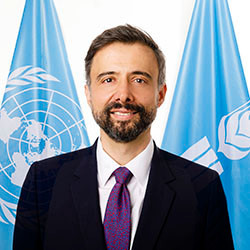Great Green Wall - IGREENFIN High-level event at COP27
IFAD Asset Request Portlet
Publicador de contenidos
Great Green Wall - IGREENFIN High-level event at COP27
Opening Address by Alvaro Lario, IFAD President
Por Alvaro Lario
A very warm welcome to this discussion on the Great Green Wall.
In truth, what we are talking about is not actually a wall. Rather, it is a visionary project to adapt to the impact of climate change with all of its shifts and challenges. It’s a plan for local communities to continue to living in the Sahel, and even thrive.
You could say it is a doorway to a more sustainable future.
Initially, the Great Green Wall was conceived as a natural barrier of trees. But this has evolved, so now we are talking about a fully comprehensive and integrated approach to development.
This approach with a wider view of the complex and interconnected challenges – including drought, climate change, poverty, hunger, unrest and migration.
Everyone here knows how serious a threat climate change is to humanity. And we know the heavy burden that the COVID pandemic and conflict have placed on global economies and societies.
But as bad as things are around the world, the scale and intensity are even greater in the Sahel.
The Sahel is the poorest and most fragile region on earth. Not one country is on track to meet the first Sustainable Development goal -- to end extreme poverty; or the second – for zero hunger – by 2030. Half of the countries in West and Central Africa are fragile, in conflict-affected situations, and facing the highest level of ecological threat.
Climate change is multiplying the risks because it fuels conflict and undermines peace and stability. It worsens poverty and hunger. It leads to competition for scare natural resources. And it even drives people to migrate.
According to the IPCC, crop yields may drop 10 to 20 per cent in the next 28 years in the region. In Chad and Niger, the entire rainfed agriculture sector could be lost by 2100. In Mali, cereal harvests could decline by 30 per cent.
Overcoming these challenges will not be easy. It requires a sustained and collective response. The international community has initiated many bold agendas to protect the planet and improve human well-being, such as the 2030 Agenda, the Paris Climate Agreement and the Africa Union’s 2063 Agenda.
But when it comes to the Sahel, only the Great Green Wall is designed to overcome all the development challenges specific to the region.
With years of experience investing in the Great Green Wall, and the publication of a report in September 2020 outlining the main achievements and challenges, we have a good idea of what needs to be done for better impact on the ground.
First, we must ensure that environmental gains truly benefit the poorest and most food insecure people.
Second, we need to go modular when targeting different groups, because one size does not fit all. Pastoralists, small-scale farmers, youth, indigenous peoples and women – all face different challenges and cultural norms.
For example, because land restoration mainly benefits those who have access to land, some women and youth have actually been disadvantaged by the programme.
Third, we must invest in better data collection so that we can see what works and what doesn’t. For example, satellites can provide vital information on changes in vegetation.
For more than 40 years, IFAD has worked with the most marginalized people in the most fragile areas in the world, including the Sahel.
We have hands-on experience of what can be done to reverse land degradation, to feed farming communities even during times of drought, and for poor rural women and men to improve their lives and livelihoods.
For the Great Green Wall to succeed, it needs donor financing, and lots of it.
IFAD can help here, too, as an assembler of finance and as the main financier for the Agriculture sector.
One of IFAD’s main contributions is through the Inclusive Green Financing Initiative – IGREENFIN. We are implementing IGREENFIN in partnership with the GCF in five Great Green Wall countries.
Through IGREENFIN, we are working with national banks to remove the barriers that prevent small-scale farmers from accessing finance. The initiative is innovative because it provides concessional credit lines tailored to Micro, Small, Medium Enterprises, Farmers Organizations and Cooperatives. It also targets young people, and organizations led by women, and provides climate-friendly financial incentives.
The initiative will help small-scale farmers to adopt the best practices to adapt to climate change, and to benefit from renewable energy technology. It directly targets around 300,000 small-scale farmers.
There is a great opportunity for local farmers across the Sahel to lead on Great Green Wall initiatives. IFAD’s experience shows that community-driven development makes a huge difference to successful outcomes, especially in fragile situations.
Today’s problems are complex but not insurmountable.
The more we can find new ways to partner together, mobilize funds and expand green markets – the more likely we are to make a difference. By working together through initiatives like the Great Green Wall, we can open a door to a better future.
